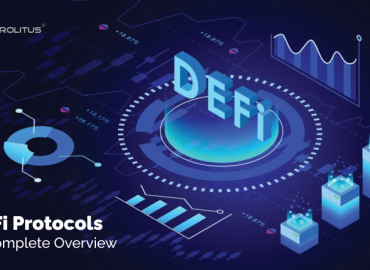Introduction: Exploring the DeFi Collateral Evolution
Decentralized Finance (DeFi) has revolutionized the traditional financial landscape, offering an inclusive and permissionless ecosystem for various financial services. Central to the success of DeFi is the concept of collateralization, enabling users to borrow, lend, and participate in various protocols using their digital assets as collateral.
In its early stages, DeFi primarily relied on single assets as collateral, with users locking up their cryptocurrencies to access loans or yield farming opportunities. However, as the DeFi space matured, developers and innovators began to explore more sophisticated collateralization methods.
This blog aims to delve into the fascinating journey of DeFi collateral evolution, tracking the transition from single asset collateral to more advanced approaches like utilizing LP (Liquidity Provider) tokens and exploring beyond single tokens. We’ll explore the challenges and risks associated with these innovations, the role of oracles in ensuring reliable collateral valuations, and how smart contract upgrades have paved the way for more diversified and secure collateral options.
Moreover, this blog will shed light on the emergence of cross-chain collateralization, allowing users to use assets from different blockchain networks as collateral for DeFi activities. We’ll also discuss the latest trends and innovations in the DeFi space, such as flash loans and other unique collateralization methods that have added new dimensions to the DeFi ecosystem.
Ultimately, understanding the evolution of DeFi collateral is crucial for anyone looking to participate in this rapidly expanding financial landscape. By grasping the developments and challenges in this field, we can better prepare ourselves for the future of decentralized finance and its potential to reshape global financial systems. So, let’s embark on this journey of DeFi collateral evolution, exploring how it has transformed the world of finance and what exciting possibilities lie ahead.
DeFi Collateral: A Brief Overview of Single Assets
In the early days of decentralized finance (DeFi), collateralization primarily revolved around the use of single assets. The concept was simple: users could lock up a specific cryptocurrency as collateral to gain access to various financial services within the DeFi ecosystem.
The most common example of single asset collateral in DeFi is the use of popular cryptocurrencies like Ethereum (ETH) or stablecoins like DAI. Users would deposit these assets into smart contracts, and in return, they could borrow other assets, earn interest through lending, or participate in yield farming protocols.
Borrowing: One of the fundamental use cases of single asset collateral in DeFi is borrowing. Users could lock up their cryptocurrency as collateral and then borrow other assets, such as stablecoins or other tokens, up to a certain percentage of the collateral’s value. This system allowed users to access liquidity without needing to sell their assets, providing them with more financial flexibility.
Lending: Single asset collateral also facilitated lending in DeFi. Users who were willing to lend their assets to others could deposit them into lending protocols. In return, they would earn interest on their deposited assets as borrowers paid back their loans.
Yield Farming: Yield farming became a popular practice in DeFi, and it often involved single asset collateral. Users would provide liquidity to liquidity pools in decentralized exchanges (DEXs) by depositing equal amounts of two assets, often referred to as a liquidity pair. They would receive LP tokens in return, representing their share of the liquidity pool. These LP tokens could then be staked as collateral in other protocols to earn additional rewards, such as governance tokens or fees from the DEX.
While the single asset collateral approach was instrumental in kickstarting DeFi and attracting early adopters, it also came with some limitations and risks. For instance, the value of the collateral could be volatile, leading to liquidation if the value fell below a certain threshold. Moreover, the lack of diversification could expose users to higher risks in case of market downturns.
Nonetheless, single asset collateral served as a solid foundation for the further evolution of DeFi collateralization methods, leading to the exploration of more sophisticated and diverse collateral options in the DeFi space. In the subsequent sections of this blog, we will explore how DeFi collateral has evolved beyond single assets, incorporating LP tokens and even exploring collateral pools with multiple assets to enhance the robustness and efficiency of the DeFi ecosystem.
Leveraging LP Tokens: The Rise of DeFi Collateralization
As the DeFi space continued to evolve, developers and users sought more innovative ways to utilize their assets as collateral. This led to the rise of DeFi collateralization through LP (Liquidity Provider) tokens. LP tokens are generated when users provide liquidity to decentralized exchanges (DEXs) or automated market makers (AMMs) by depositing equal values of two different assets into a liquidity pool.
The process of leveraging LP tokens as collateral introduced several advantages and new opportunities within the DeFi ecosystem:
- Diversification: LP tokens represent a combination of two assets, providing built-in diversification. This diversification helps reduce the risk associated with single asset collateral, as the value of LP tokens is determined by the performance of both assets in the pool.
- Enhanced Yield Farming: By staking LP tokens as collateral, users can further optimize their yield farming strategies. They can take advantage of multiple DeFi protocols simultaneously, earning rewards and fees from both the liquidity pool and the additional DeFi platform where the LP tokens are staked.
- Increased Efficiency: Leveraging LP tokens as collateral streamlines the process for users who are already providing liquidity to DEXs. Instead of withdrawing assets from a liquidity pool to use them as collateral elsewhere, users can directly use the LP tokens, saving on gas fees and transaction times.
- Broader Access to DeFi Services: LP token collateralization opens up opportunities for liquidity providers to engage in lending, borrowing, and other DeFi activities without disrupting their liquidity provision activities. This flexibility encourages more users to participate in DeFi services.
- Governance Participation: Some DeFi platforms offer governance tokens as rewards for staking LP tokens as collateral. This incentivizes users to participate in the governance of various protocols, giving them a voice in the decision-making processes.
- Protocol Stability: Increased liquidity and usage of LP tokens as collateral can lead to greater stability and efficiency in DeFi protocols, as liquidity providers are less likely to be forced into liquidation due to sudden price fluctuations.
However, leveraging LP tokens as collateral also presents its challenges and risks. For instance, LP tokens can be more complex than single assets, making it crucial for users to thoroughly understand the underlying mechanisms and risks associated with specific liquidity pools. Additionally, users must be cautious about impermanent loss, a phenomenon that can affect the value of LP tokens compared to holding the underlying assets separately.
Despite these challenges, the rise of LP token collateralization has significantly expanded the possibilities within the DeFi landscape, enabling a more efficient, diversified, and inclusive ecosystem for users seeking to maximize the potential of their assets. As DeFi continues to innovate, it is likely that LP tokens will remain an integral part of the collateralization process, offering unique benefits to the broader DeFi community.
DeFi Collateral Pools: Exploring Beyond Single Tokens
As the DeFi space continued to grow and mature, innovators and developers sought to push the boundaries of collateralization even further. This led to the exploration of DeFi collateral pools, a concept that expands beyond the use of single assets or LP tokens as collateral. DeFi collateral pools allow users to pool together multiple assets and use them collectively as collateral for various financial activities within the DeFi ecosystem.
Here’s how DeFi collateral pools work and why they have gained popularity:
- Pooling Multiple Assets: DeFi collateral pools enable users to contribute a diverse range of assets into a single pool. These assets can be cryptocurrencies, stablecoins, or even tokens from other blockchains (through interoperability solutions).
- Shared Collateralization: By pooling assets, users collectively share the risk associated with collateral volatility. This shared collateralization approach helps reduce the individual risk exposure compared to using single assets as collateral.
- Flexible Borrowing and Lending: Collateral pools allow for flexible borrowing and lending options within the DeFi ecosystem. Users can access loans or borrow assets from the pool based on the value of their contributed assets.
- Enhanced Stability and Efficiency: The pooled collateral approach can lead to greater stability for DeFi protocols, as the risk is distributed across multiple assets. Additionally, it can improve the efficiency of the lending and borrowing process, making it more accessible to a broader range of users.
- Governance and Voting: Some DeFi protocols that implement collateral pools may also introduce governance tokens for pool contributors. This incentivizes active participation and allows contributors to have a say in the decision-making processes of the protocol.
- Cross-Chain Collateralization: Collateral pools can also facilitate cross-chain collateralization, allowing users to contribute assets from different blockchain networks into the same pool. This interoperability further enhances the flexibility and utility of collateral pools.
As DeFi continues to evolve, it is likely that collateral pools will remain an essential component of the ecosystem, providing users with more opportunities to engage in a wide range of financial activities while mitigating risks and enhancing overall stability.
The Role of Oracles in DeFi Collateral Evolution
Oracles play a crucial role in the evolution of DeFi collateral by providing reliable and accurate external data to smart contracts. In the context of DeFi, oracles are third-party services that fetch and verify real-world data, such as asset prices, exchange rates, and other relevant information. This data is then fed into smart contracts to trigger actions or decisions based on specific conditions.
The importance of oracles in DeFi collateral evolution can be understood in the following ways:
- Asset Valuation: Oracles provide the necessary price feeds for various assets used as collateral within DeFi protocols. For instance, when a user locks up an asset as collateral to borrow another asset, the smart contract needs to know the current market value of the locked asset. Oracles supply this data, ensuring that collateralization ratios are maintained and liquidations are triggered accurately in case of price fluctuations.
- Liquidation Mechanisms: In DeFi lending platforms, where users can borrow against their collateral, oracles play a critical role in the liquidation process. If the value of the collateral falls below a certain threshold, the smart contract may trigger liquidation of the collateral to cover the borrowed amount. Oracles provide up-to-date price information to determine when and how much to liquidate.
- Verifying Collateral Composition: In more complex collateralization mechanisms, such as collateral pools or LP token collateral, oracles may be involved in verifying the composition of the collateral. For instance, if a collateral pool contains multiple assets, oracles can confirm the actual value of the assets and their weightage in the pool.
- Flash Loans: Flash loans are a unique DeFi feature that allows users to borrow assets without any initial collateral, provided they return the borrowed amount within the same transaction. Oracles play a vital role in these flash loan mechanisms by ensuring that borrowed funds are returned within the same transaction, mitigating the risk of potential exploits.
As DeFi continues to evolve and collateralization methods become more sophisticated, oracles will remain a critical infrastructure layer, ensuring the accurate functioning of smart contracts and the integrity of the collateralization process. Collaborations between DeFi projects and reputable oracle providers will be essential to building a sustainable and secure DeFi ecosystem for the future.
The Emergence of Cross-Chain Collateralization in DeFi
The emergence of cross-chain collateralization in DeFi represents a significant advancement in the decentralized finance space. Cross-chain collateralization allows users to utilize assets from one blockchain network as collateral for borrowing or lending on a different blockchain. This capability breaks down the barriers between various blockchain ecosystems, enabling greater interoperability and flexibility in DeFi.
Here are some key aspects of cross-chain collateralization in DeFi:
- Interoperability: Different blockchains often operate in isolation, and assets are typically confined within their respective networks. Cross-chain collateralization bridges this gap, enabling users to bring assets from one blockchain into the DeFi ecosystem of another blockchain. For example, users can use assets from Ethereum to collateralize borrowing on a Binance Smart Chain DeFi protocol.
- Diversification: Cross-chain collateralization allows users to diversify their collateral holdings across multiple blockchain networks. This diversification can help reduce risks associated with single-chain collateral, as assets are spread across different ecosystems.
- Access to Different Liquidity Pools: By leveraging cross-chain collateralization, users gain access to a broader range of liquidity pools and DeFi protocols. They can participate in borrowing, lending, yield farming, and other activities on networks that might offer better rates or more attractive opportunities.
- Leveraging Specialized Features: Different blockchains have unique features and characteristics. Cross-chain collateralization allows users to take advantage of specific features offered by different DeFi ecosystems.
- Enhanced DeFi Adoption: Cross-chain collateralization makes DeFi more accessible to users who prefer one blockchain over another. They can utilize their preferred assets as collateral and engage with DeFi protocols on multiple chains.
Despite the advantages, cross-chain collateralization also comes with challenges. Ensuring secure and efficient communication between different blockchain networks can be complex. Interoperability solutions, such as bridge protocols and cross-chain bridges, play a crucial role in facilitating the movement of assets between chains.
As the DeFi space continues to evolve, cross-chain collateralization is likely to play an increasingly important role, opening up new possibilities for users and expanding the reach of decentralized finance across the broader blockchain ecosystem.
The Final Thought: The Ongoing Journey of DeFi Collateral Evolution
In conclusion, the evolution of DeFi collateral has been a fascinating journey, reflecting the rapid growth and innovation within the decentralized finance space. From its early days of single asset collateral to the rise of LP tokens and the exploration of collateral pools and cross-chain solutions, DeFi has continuously pushed the boundaries of what is possible in the world of finance.
The introduction of LP tokens and collateral pools has enhanced the efficiency, diversification, and accessibility of DeFi services, empowering users to maximize the potential of their assets while mitigating risks. At the same time, the integration of oracles has ensured the reliability and accuracy of external data, safeguarding the integrity of the collateralization process.
As DeFi continues to mature, we anticipate further advancements in collateralization methods, with the potential integration of real-world assets, AI-driven models, and increased cross-asset collateralization. The DeFi ecosystem’s evolution will require a balance between innovation and security, as developers work to implement robust measures that protect user funds and maintain the decentralized ethos of the space.
Regulatory considerations will also play a crucial role as DeFi gains broader adoption and attention. Striking the right balance between regulatory compliance and preserving DeFi’s permission less and open nature will be key to ensuring its continued growth and sustainability.
The ongoing journey of DeFi collateral evolution is a testament to the power of decentralized finance in reshaping global financial systems. It has opened up new possibilities for financial inclusion, providing individuals with greater control over their assets and the ability to access a wide range of financial services without intermediaries.
As we look to the future, the transformative potential of DeFi development remains vast, and collaboration among stakeholders will be pivotal in driving responsible innovation and building a more equitable and accessible financial future for all. Embracing this ongoing journey with a commitment to security, innovation, and user empowerment will be the driving force behind the continued success of DeFi and its evolution as a fundamental pillar of the global financial landscape.





